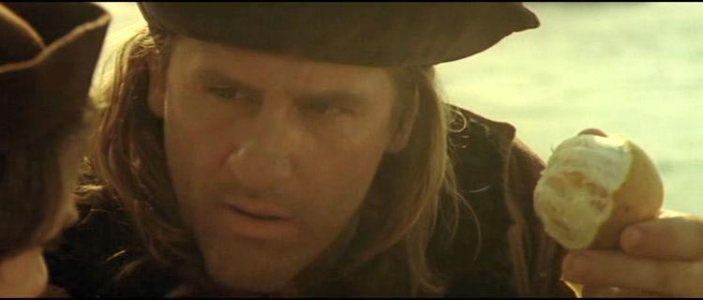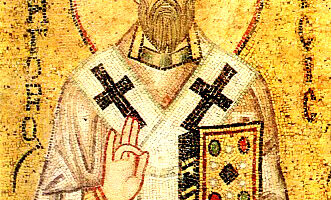Christopher Columbus, with an orange on his hand, explains to his son that “the world is round” (like it was something incredibly revolutionary and unknown at that time). A few moments later, the Genovese explorer says to a monk: “We’ve been told lies for so long….. they said that this (pointing to a globe) was flat as this table……that monsters guard the edge of the world!”
Those are famous scenes from “1492: conquest of paradise” (1992) — Hollywood movie that has been used in classes by several school teachers in Brazil and all over the world. Few people note that obvious errors widespread by films like that, since they have heard multiple times the following false information: during the middle ages, the Earth was believed to be flat; the Catholic Church denied the sphericity and persecuted its defenders; then came a heroic and rebellious innovator, Cristopher Columbus, who in 1492 managed to, despite all the ignorant thinking from his time, prove that our planet was round.
Those above statements are part of what historians call “myth of the flat Earth”. The Italian explorer’s idea, the alternative route to the East Indies (towards the west, by the Atlantic Ocean, in order to reach the east), indeed only made since in a spherical Earth. However, scholars, like historians of science Ronald L. Numbers and David C. Lindberg, teach that nearly all medieval (V to XV century) scholars affirmed the sphericity of our planet and knew its circumference.
To clear this matter, one can utilize works from several scholars (like James Hannam or the late Stephen Jay Gould, for example). Because of its notorious quality, I’ve decided to use the book “Galileo goes to jail and other myths about science and religion”. Published by Harvard University Press and edited by the renowned intellectual Ronald L. Numbers (awarded the George Sarton medal – the most prestigious honor to a historian of science), the book gathers 25 acclaimed historians of science, each one rebutting a myth about the relationship between science and religion. The chapter called “Myth 3. That medieval Christians Taught that the Earth was flat” was written by Lesley B. Cormack, PhD. and President of the “Canadian Society for the History and Philosophy of Science”, and will serve as base for the following explanations.
Initially, it is important to inform that the myth appearead during the 19th century. At that time, there was a strong anti-Catholic sentiment among American academics like Andrew Dickson White and John Draper, interested in spreading the idea of a never-ending conflict between science and religion. Some argue that the Greek knew Earth’s sphericity (a fact indeed) and that knowledge was suppressed by the medieval Christian clerics. In that environment, a romanticized biography of Columbus, written by American Washington Irving (famous for his short stories “Rip Ban Winkle” and “Sleepy Hollow”), brings to the world the fantasized report (and still today the current version of the myth) that it was that Italian navigator the first man to prove our planet was round and that the Church and its thinkers defended a flat planet. Well, Columbus could not have proved such fact, because it was already known. He was also not a modern rebel, but a good catholic who, just like medieval Church members, was interested in unveiling God’s work in nature.
Since Antiquity, all major scholars of Geography, Greeks (like Eratosthenes, third century B.C.; Aristotle, 384-322 B.C.; and Ptolemy, second century A.D.) and Romans (Pliny, the Elder – 23-79 A.D.; Macrobius, fourth century A.D.; and Pomponius Mela, first century A.D.), based their works on a round world. For instance, Aristotle’s proof of the sphericity of the world (indicated by the changing positions of the costtelations as one moved about on the earth’s surface) was used as argument for many thinkers of the Middle Age and Renaissance. Also, Eratosthenes, almost two thousand and three hundred years ago, had the great feat of calculating the approximated circumference of the Earth.
But did the medieval writers follow those teachings? Yes, even in the first moments of the Middle Ages, almost every single one of them defended a Spherical-Earth. It was no different among the Church Doctors like St. Augustine (354-430), St. Gerome (d.420) and St. Ambrose (d. 420), who all agreed our planet was round. A dissident view came only with came with Lactantius (early fourth century), but he rejected any pagan learning.
Nothing changed after that. From the VI to XIV century, every major medieval scholar pretty much stated that the Earth was a round globe, such as: St. Thomas Aquinas (d. 1274- the most influential Theologian in Catholic Church’s history); and one of the great fore thinkers of the scientific method, the Franciscan Friar Roger Bacon (d.1294). The most influential intellectual from the field were: Jean de Sacrobosco (demonstrated Earth was a glove in his work “De Sphera” – 1230, used as manual in medieval Universities, created by the Church); and Pierre d’Ailly (1350-1410]0, Archbishop of Cambrai (whose “Imago Mundi”, written in 1410, was also extremely popular — read by early explorers like Columbus.
All of those illustrious and revered Catholics (lots of them venerated as Saints) help to show the lack of merit in the reasoning that the Church defended a “Flat Earth” and persecuted those who denied it.
Popular works also supported the idea of a round Earth, like “Travels” by Jean de Manderville (one of the most read books in Europa between the fourteenth and sixteenth century), the epic “Divine Comedy” by Dante Alighieri (!265-1321) and “The Franklin’s tale” by Chaucer (ca.1340-1400). For example, Manderville wrote: “And therefore I say sickerly that a man myght go all the world about, both above and beneath, and come again to his own country . . . And alway he should find men, lands, isles and cities and towns, as are in their countries”.
Only one author from the Middle Ages, Cosmas Indicopleustes (a Byzantine Monk from the sixth century), explicitly denied our planet’s sphericity. Nonetheless, only one medieval man is known to have read his work, Photius of Constantinople (d.891), widely considered the best-read man of his age. Cosmas’s work, since there is no positive evidence, cannot be used to argue that the Church suppressed knowledge about the roundness of the globe; it only shows an openness to debate in early-medieval scholarly climate. Also worth to notice that the Byzantine Monk lived nine centuries before 1492. Thus, there is nothing that indicates any western scholar at Columbus’s time (or even in the earlier previous centuries) who defended a flat Earth.
Ultimately, about the medieval scholars, the Church and Columbus, Dr. Lesley Cormack teaches:
With the exceptions of Lactantius and Cosmas, all major scholars and many vernacular writers interested in the physical shape of the earth, from the fall of Rome to the time of Columbus, articulated the theory that the earth was round. The scholars may have been more concerned with salvation than with geography, and the vernacular writers may have displayed little interest in philosophical questions. But, with the exception of Cosmas, no medieval writer denied that the earth was spherical—and the Catholic church never took a stand on the issue.
Given this background, it would be silly to argue that Columbus proved the world was round—or even argued so. However, pop u lar accounts continue to circulate the erroneous story that Columbus fought the prejudiced and ignorant scholars and clerics at Salamanca, the home of Spain’s leading university, before convincing Queen Isabella to let him try to prove his position.
The author also explains that there was wasn’t, among Columbus’s sailors, the fear of “falling off the end of the Earth”. According to the Genovese’s own diary, those had only two complains: the worry that the journey was taking more that Columbus promised; and the fear that they would not be able to make their voyage back east, because the wind seemed to blow constantly due west.
Although the sphericity of our planet was not discussed, there was indeed controversies among Columbus and the wise men of Salamanca (who “were aware of the current debates about the size of the earth, the likelihood of inhabitants in other parts of the world, and the possibility of sailing through the torrid zone at the equator”). They questioned him about his claim to have a superior knowledge than the ancients and argue that the spherical Earth was larger than Columbus claimed to be (he was indeed wrong in believing that our planet was smaller than it really is), doubting that the Genovese navigator could do what he proposed (the wise men had good reasons to be skeptic, because Columbus would probably have failed if there wasn’t an unknown American Continent in the middle of the way).
At last, it also crucial to inform that, while praising Columbus in his laudatory preface to De cades of the New World (1511), Peter Martyr mentioned the main achievements of that explorer: proving “the equator was passable and that there were indeed peoples and lands in those parts of the globe once thought to have been covered with water”. Of course, there was not a single word claiming Columbus had proven the sphericity of our planet.
Therefore, as well explained by Dr. Cormack, Columbus did not prove the Earth was round, he just “stumbled on a continent that happened to be in his way”.
The legend created mostly by Washington Irving is still popular, despite being dead in the academic field. Several movies and TV series help spread the myth, for example:
1. Star Trek V: The final frontier (1989). In the film, the alien character Sybok says to a human being: “The people of your world once believed the world was flat. Columbus proved it was round”;
2. Stargate Atlantis (2004). In this TV series, “Captain Griffin” states: “Columbus was Spanish – he figured out the Earth was round”;
3. Men in Black (1997). In this blockbuster, Agent K (Tommy Lee Jones) says to Agent J (Will Smith): “Fifteen hundred years ago everybody knew the Earth was the center of the universe. Five hundred years ago, everybody knew the Earth was flat, and fifteen minutes ago, you knew that humans were alone on this planet.”
It is possible to understand historic mistakes made by the entertainment industry, since it priorizes fun and show a romanticized view of history. As we said, some movies like “1492” reached classrooms. Moreover, do school teachers still spread that myth to students?
Unfortunately, according to Dr. Leslie Cormack, there still are in the United Sates secondary school textbooks authors that repeat the legend, like: Mounir A. Farah and Andrea Berens Karls, World History: The Human Experience (Lake Forest, Ill.: Glencoe/McGraw- Hill, 1999); and Charles R. Coble et al., Earth Science (Englewood Cliffs, N.J.: Prentice Hall, 1992). In order to try answer that question in regard to Brazil, I made a quick search on “youtube” and watched a few classes of acting and popular Brazilian school educators. The results were terrifying: no teacher explained that in Columbus’s era, man knew for a long time about Earth’s sphericity and, worse, some told the legend as history to their students. Next, three examples (I’ve decided to preserve their identities), all of them with thousands of views on their videos:
1. A teacher passed the wrong idea that the Columbus believe in Earth’s sphericity (besides thinking that he “would not fall in the deep abyss of the tenebrous see”) because he had a “Renaissance thinking”;
2. If the first one spread the myth in a moderate way, the second teacher goes beyond and, in a complete misrepresentation of history, claims that the Catholic Church defended a “squared Earth” and that the Genovese proved, with his “crazy theories for that time”, that “earth is round”.
3. A third teacher makes a surreal mess between Heliocentrism and Earth’s sphericity, by saying that some thinkers like Copernicus and Galileo “stated the possibility of Planet Earth being round, when most people considered that silly”. Later, he claims that there was a navigator, Columbus, who “believed in that possibility”. My God! In 1492, when Columbus reached the Americas, Copernicus was still a young man initiating his study at the University of Krakow and Galileo (1564–1642) was not even born yet!
Unfortunately, lots of young students still continue to learn such notorious false information, totally refuted by the specialized historians. It all happens in “history classes”. A more tenebrous picture than any unknown ocean or Hollywood movie.




